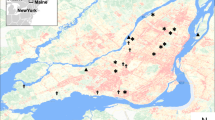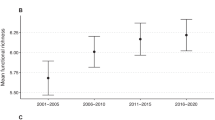Abstract
Predacious syrphid fly species, also known as flower flies or hover flies, are cosmopolitan diptera that play two important ecological roles: predator and pollinator. In decades past, syrphid flies were studied by agricultural researchers due to their larvae’s ability to function as a biological control agent. In recent years, the global decline in both honey bees and various important wild bee species has led ecological researchers to investigate the role of syrphid fly pollination in both natural systems and agriculture. While these two roles have often been considered separately, they are rarely considered together in single studies. Syrphid fly population fluctuations in natural and agricultural systems are understudied, prompting calls for further study into the fundamental drivers of population dynamics of syrphid communities. In order to develop a deeper understanding of the fundamental dynamics of syrphid ecology, the present study offers a community model where both syrphid predation and pollination are incorporated into a single dynamic model. Using populations of predacious syrphid flies, herbivorous insects, and a shared resource flowering plant, the model is used to investigate community dynamics and persistence across different levels of plant reproductive dependence on syrphid pollination. Results indicate distinct levels of community viability across different pollination relationships as well as a tendency toward chaotic dynamics inherent to the trophic interactions of the community.







Similar content being viewed by others
References
Aizen MA, Harder LD (2009) The global stock of domesticated honey bees is growing slower than agricultural demand for pollination. Curr Biol 19:915–918
Aizen MA, Garibaldi LA, Cunningham SA, Klein AM (2008) Long-term global trends in crop yield and production reveal no current pollination shortage but increasing pollinator dependency. Curr Biol 18:1572–1575
Bahmeier FA, Bernardino CS, Bradley JC (1918) Official Organ American Association of Economic Entomologists. J Econ Entomol 11:275
Bargen H, Saudhof K, Poehling H (1998) Prey finding by larvae and adult females of Episyrphus balteatus. Entomologia Experimentalis et Applicata 87:245–254
Bergh JC, Short BD (2008) Ecological and life-history notes on syrphid predators of woolly apple aphid in Virginia, with emphasis on Heringia calcarata. BioControl 53:773–786. doi:10.1007/s10526-007-9114-0
Berry RE. (1998) Insects and mites of economic importance in the northwest. 2nd Ed. 221 p
Biesmeijer JC, Roberts SPM, Reemer M, Ohlemüller R, Edwards M, Peeters T, Schaffers AP, Potts SG, Kleukers R, Thomas CD, Settele J, Kunin WE (2006) Parallel declines in pollinators and insect-pollinated plants in Britain and The Netherlands. Science 313(5785):351–354
Bingham RA, Orthner AR (1998) Efficient pollination of alpine plants. Nature 391(6664):238–239
Bischoff M et al (2013) The relative importance of solitary bees and syrphid flies as pollinators of two outcrossing plant species in the New Zealand alpine. Austral Ecol 38(2):169–176
Cameron SA et al (2011) Patterns of widespread decline in north American bumble bees. Proc Natl Acad Sci U S A 108(2):662–667
Chandler AEF (1969) Locomotive behavior of first instar larvae of aphidophagous Syrphidae (Diptera) after contact with aphids. An. Behav. 17:673–678
Conner JK, Rush S (1996) Effects of flower size and number on pollinator visitation to wild radish, Raphanus raphanistrum. Oecologia 105(4):509–516
Cowgill SE, Wratten SD, Sotherton NW (1993) The effects of weeds on the numbers of hoverfly (Diptera: Syrphidae) adults and the distribution and composition of their eggs in winter wheat. Ann Appl Biol 123:499–515
Dibbs H, Jamont M, Sauphanor B, Capowiez Y (2011) Predation potency and intraguild interactions between generalist (Forficula auricularia) and specialist (Episyrphus balteatus) predators of the rosy apple aphid (Dysaphis plantaginea). Biol Control 59:90–97
Elberling H, Olesen JM (1999) The structure of a high latitude plant-flower visitor system: the dominance of flies. Ecography 22:314–323
Faegri K. & van der Pijl L (1979) The Principles of Pollination Ecology. Pergamon Press, Oxford
Feldman TS (2006) Pollinator aggregative and functional responses to flower density: does pollinator response to patches of plants accelerate at low-densities? Oikos 115:128–140
Fontaine C, Dajoz I, Meriguet J, Loreau M (2006) Functional diversity of plant–pollinator interaction webs enhances the persistence of plant communities. PLoS Biol 4(1):1029–1035
Forister ML et al (2015) The global distribution of diet breadth in insect herbivores. Proc Natl Acad Sci 112(2):442–447
Futuyma DJ, Gould F (1979) Associations of plants and insects in deciduous forest. Ecol Monogr 49(1):33–50
Glaum PR (2014) Dual invasion analysis: a general model of novel ecological dynamics due to Bt product and resistant pests in wild settings. Theor Ecol 7(2):181–194
Gosselke U, Triltsch H, Roßberg D, Freier B (2001) GETLAUS01—the latest version of a model for simulating aphid population dynamics in dependence on antagonists in wheat. Ecol Model 145(2):143–157
Gross J, Fatouros NE, Neuvonen S, Hilker M (2004) The importance of specialist natural enemies for Chrysomela lapponica in pioneering a new host plant. Ecol Entomol 29:584–593
Haenke S (2014) Landscape configuration of crops and hedgerows drives local syrphid fly abundance. J Appl Ecol 51(2):505–513
Haenke S, Scheid B, Schaefer M, Tscharntke T, Thies C (2009) Increasing syrphid fly diversity and density in sown flower strips within simple vs. complex landscapes. J Appl Ecol 46:1106–1114
Haslett JR (1989) Interpreting patterns of resource utilization: randomness and selectivity in pollen feeding by adult hoverflies. Oecologia 78:433–442
Hastings A, Powell T (1991) Chaos in a three species food chain. Ecology 72(3):896–903
Herrera CM (1987) Components of pollinator “quality”: comparative analysis of a diverse insect assemblage. Oikos 79–90
Herrera CM (1988) Variation in mutualisms: the spatio-temporal mosaic of a pollinator assemblage. Biol J Linn Soc 35:95–125
Hopper JV, Nelson EH, Daane KM, Mills NJ (2011) Growth, development and consumption by four syrphid species associated with the lettuce aphid, Nasonovia ribisnigri, in California. Biol Control 58(3):271–276
Howard PH (2009) Visualizing consolidation in the global seed industry: 1996–2008. Sustainability 1(4):1266–1287. doi:10.3390/su1041266
Iler AM et al (2013) Maintenance of temporal synchrony between syrphid flies and floral resources despite differential phenological responses to climate. Glob Chang Biol 19(8):2348–2359
Jarlan A, Gingras J (1997) Pollination by Eristalis tenax (Diptera: Syrphidae) and seed set of greenhouse sweet pepper. J Econ Entomol 90(6):1646–1649
Jauker F, Wolters V (2008) Hover flies are efficient pollinators of oilseed rape. Oecologia 156:819–823
Kan E (1988) Assessment of aphid colonies by hoverflies. II pea aphids and 3 syrphid species; Betasyrphus serarius (Wiedemann), Metasyrphus frequens Matsumura and Syrphus vitripennis (Meigen) (Diptera: Syrphidae). J Ethol 6(2):135–142
Kearns CA (1992) Anthophilous fly distribution across an elevation gradient. Am Midl Nat 127:172–182
Kearns CA (2001) North American dipteran pollinators: assessing their value and conservation status. Conserv Ecol 5(1):5 [online] URL: http://www.consecol.org/vol5/iss1/art5/
Kearns CA, Inouye DW (1994) Fly pollination of Linum lewisii (Linaceae). Am J Bot 8:1091–1095
Kevan, Peter G (1972). Insect pollination of high arctic flowers. Afr J Ecol: 831–847.
Khan AA, Shah MA, Majid S (2016) Functional response of four syrphid predators associated with green apple aphid (Hemiptera: Aphididae) in laboratory. J Econ Entomol 109(1):78–83
Kühsel S, Blüthgen N (2015) High diversity stabilizes the thermal resilience of pollinator communities in intensively managed grasslands. Nat Commun 6
Lövei GL, Macleod A, Hickman JM (1998) Dispersal and effects of barriers on the movement of the New Zealand hover fly Melanostoma fasciatum (Dipt., Syrphidae) on cultivated land. J Appl Entomol 122.1(5):115–120
Michaud JP (1999) Sources of mortality in colonies of brown citrus aphid, Toxoptera citricida. BioControl 44:347–367
Miller D (1918) The economic bearing of hover-flies. New Zealand Journal of Agriculture 1918, September 20th 17(3):129–135
Nye WP, Anderson JL (1974) Insect pollinators frequenting strawberry blossoms and the effect of honeybees on yield and fruit quality. J Am Soc Hortic Sci 99:40–44
Otto SB, Berlow EL, Rank NE, Smiley J, Brose U (2008) Predator diversity and identity drive interaction strength and trophic cascades in a food web. Ecology 89(1):134–144
Pellmyr O, Thompson JN (1996) Sources of variation in pollinator contribution within a guild: the effects of plant and pollinator factors. Oecologia 107:595–604
Potts SG et al (2010) Global pollinator declines: trends, impacts and drivers. Trends Ecol Evol 25(6):345–353
Primack RB (1983) Insect pollination in the New Zealand mountain flora. N Z J Bot 21(3):317–333
Richards AJ (1986) Plant Breeding Systems. 529 pp. George Allen & Unwin, London
Rush S, Conner JK, Jennetten P (1995) The effects of natural variation in pollinator visitation on rates of pollen removal in wild radish, Raphanus raphanistrum (Brassicaceae). Am J Bot 82(12):1522–1526
Sahli FS, Conner JK (2007) Visitation, effectiveness, and efficiency of 15 genera of visitors to wild radish, Raphanus raphanistrum (brassicaceae). Am J Bot 94(2):203–209
Smith HA, Chaney WE, Bensen TA (2008) Role of Syrphid Larvae and Other Predators inSuppressing Aphid Infestations in Organic Lettuce on California’s Central Coast. J Econ Entomol 101(5):1526–1532
Ssymank A, Kearns CA, Pape T, Thompson FC (2008) Pollinating flies (Diptera): a major contribution to plant diversity and agricultural production. Biodiversity 9(1–2):86–89
Strogatz SH (1994) Nonlinear Dynamics and Chaos: with Applications to Physics, Biology, Chemistry and Engineering. Westview Press, 11 Cambridge Center, Cambridge, MA 02142
Sunderland KD, Crook NE, Stacey DL, Fuller BJ (1987) A study of feeding by polyphagous predators on cereal aphids using Elisa and gut dissection. J Appl Ecol 24(3):907–933
Tamaki G, Landis BJ, Weeks RE (1967) Autumn populations of green peach aphid on peach trees and the role of Syrphid flies in their control. J Econ Entomol 60(2):433–436. doi:10.1093/jee/60.2.433 433-436
Tenhumberg B (2004) Predicting predation efficiency of biocontrol agents: linking behavior of individuals and population dynamics. Faculty Publications in the Biological Sciences. Paper 184. http://digitalcommons.unl.edu/bioscifacpub/184
Tenhumberg B, Poehling HM (1995) Syrphids as natural enemies of cereal aphids in Germany: aspects of their biology and efficacy in different years and regions. Agric Ecosyst Environ 52:39–43
Toft CA (1983) Community patterns of nectivorous adult parasitoids (Diptera, Bombyliidae) on their resources. Oecologia 57:200–215
Van Der Kooi CJ, Pen I, Staal M, Stavenga DG, Elzenga JTM (2016) Competition for pollinators and intra-communal spectral dissimilarity of flowers. Plant Biol 18(1):56–62. doi:10.1111/plb.12328
van Rijn PCJ, Kooijman J, Wackers FL (2006) The impact of floral resources on syrphid performance and cabbage aphid biological control. IOBC wprs Bulletin 29(6):149
Verheggen FJ, Arnaud L, Bartram S, Gohy M, Haubruge E (2008) Aphid and Plant Volatiles Induce Oviposition in an Aphidophagous Hoverfly. J Chem Ecol 34:301–307. doiuOviposition in an Aphidophagous Hoverfly. J Chem Ecol 34:301–30. doi:10.1007/s10886-008-9434-2
Wolf A, Swift JB, Swinney HL, Vastano JA (1985) Determining Lyapunov exponents from a time series. Physica D 16:285–317
Wratten SD, Bowie MH, Hickman JM, Evans AM, Sedcole JR, Tylianakis JM (2003) Field boundaries as barriers to movement of hover flies (Diptera: Syrphidae) in cultivated land. Oecologia 134(4):605–611
Zhang C & Chen T. 2001. Efficient feature extraction for 2d/3d objects in mesh representation. 2001 Int Conf Image Process 935–938(3). doi:10.1109/ICIP.2001.958278
Acknowledgements
Thanks are due to John Vandermeer for providing the impetus to develop this model and for the essential comments on the manuscript. I also thank the Editor and Reviewers for their insightful comments, which strengthened this manuscript.
Author information
Authors and Affiliations
Corresponding author
Electronic supplementary material
ESM 1
(DOCX 1362 kb)
Rights and permissions
About this article
Cite this article
Glaum, P. A theoretical basis for the study of predatory syrphid fly ecology. Theor Ecol 10, 391–402 (2017). https://doi.org/10.1007/s12080-017-0336-1
Received:
Accepted:
Published:
Issue Date:
DOI: https://doi.org/10.1007/s12080-017-0336-1




